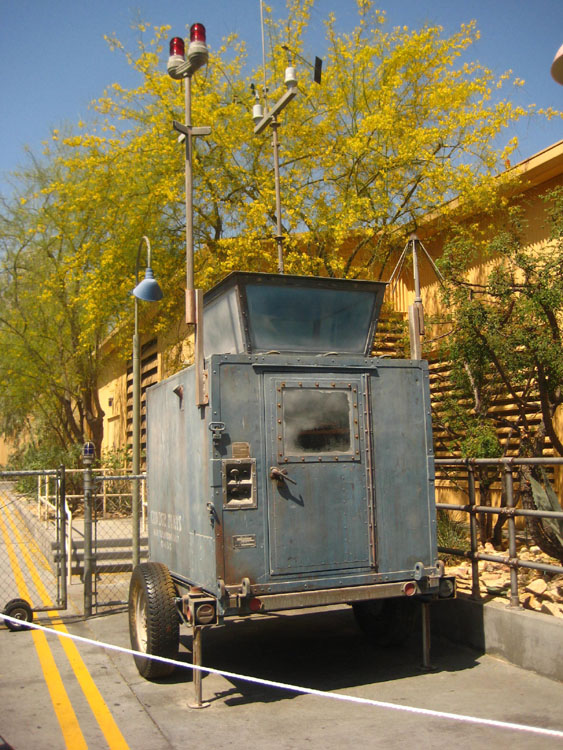
Air traffic Control Set at Soarin' Over California Ride at Disneyland California Adventures
Updated February, 2011
Updated June 29, 2011 Using in formation from Rich P.
Photos by Margret Byrnes, May 2009

In 2009 I made my first trip to see California Adventures at Disneyland. The Soarin' Over California ride was high on my list of things to see. Since my first trip to Disneyland in 1955 I have always been fascinated with the special details created for every attraction and at the Soarin' ride I was really impressed with the portable air traffic control tower. I have never seen anything like this in a documentary or movie that shows military equipment. In July 2010 I received a lot of information from the Archives Division of the Smithsonian National Air and Space Museum. This information is found at the bottom of the page. Later, in January 2011 Dave C., a retired aerospace engineer who served in Vietnam, saw the request for information about this equipment.
Here is Dave's explanation for this military artifact.
"It is in fact a TSQ6. I worked in Vietnam as an air traffic controller with a similar type of ATC unit. It is built for 2 men to operate. One person is in the glass area on a stool controlling visual traffic. This person is known as the tower controller. Down below was a radar operator guiding aircraft to the airfield when meteorological conditions required blind flying or by instruments. Not shown in your photos are the radar antennas that were usually remotely set up at the end of a runway and wired back to the TSQ unit.
Many of these units were deployed in Vietnam. Most were mounted on the back of trucks and deployed to remote locations to provide air traffic control."
Thanks for your information and allowing me to share it on this web page. For as small as this equipment is, imagine two people in Vietnam in the heat and humidity working one above the other to guide planes to a safe landing.
I commend the Disney folks for placing such an interesting artifact in the Park.
Below is the side photo and the labels on the "Shelter".
June 29, 2011 Update Information from Rich P (paraphrased by Greg Clark):
Rich was an air traffic controller in Vietnam and actually used a portable tower either identical to the one on exhibit in Disneyland or one very similar. Plus Rich photographed the tower in use and the permanent tower that replaced it. Amazingly, the smaller crew in the portable tower was able to keep up with the work load and set a new operations record held by a crew in a permanent tower. Rich was able to provide an article from Stars and Stripes highlighting this dedication and performance during wartime. Here is Rich's information and photos:
Rich was in the United States Air Force stationed in Tuy Hoa Air Base, Republic of Vietnam, as part of the 1884th Communication Squadron. Rich was one of the air traffic controllers. Because of safety, the original wood tower had to be demolished. It was deteriorating in the jungle climate of Vietnam. The portable tower was placed into service in June 1968 and was used until the late fall of 1968 while a new steel tower was constructed. The photo below shows the portable tower between the two runways, protected by sandbags. On the right are the three generators needed to keep the tower operating. Every twelve hours the generators had to be refilled. The sandbags couldn't block the dimly lit tower glass dome so there was a constant risk to the controller of being shot, to say nothing of the risk of being between the two parallel active runways. Rich says the sand bags were stacked four feet high around the tower and the generators. You can also see the aluminum matting (termed MA-2) laid out in front of the tower.
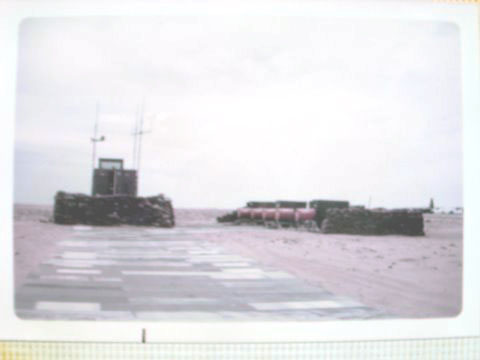
The mobile tower was operated with two controllers and sometimes a supervisor. Rich points out that in Air Traffic Controller terms the person who could see out of the dome and controlled the airborne air traffic was called the "Local Controller".
The second controller, who couldn't see out of the tower, managed the traffic on the ground. This is called the "Ground Controller".
The Stars and Stripes article, shown below, indicates that the crew set an operations record of nearly 26,000 operations in one month. Rich indicates that operations were performed from 6am to 9pm, meaning an average of around 55 operations per hour - nearly one per minute. Considering that aircraft of all types had to be accommodated, this further demonstrates the amazing skill and dedication of the crew.
The permanent Tower that replaced the small portable tower is also shown. Below the upper cab for the traffic controllers is a room for a weather observer.
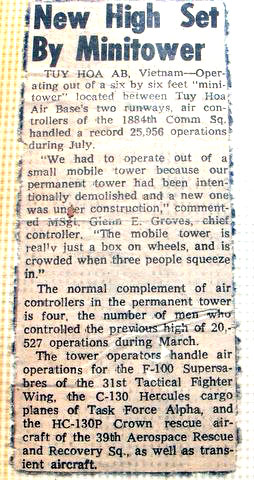
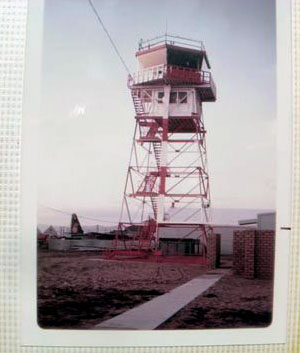
Link to 31st Tactical Fighter Wing:
http://airwarvietnam.com/31tfw.htm
C-130 Hercules cargo planes, Task Force Alpha, medical operations video link:
http://www.youtube.com/watch?v=iWjcSrPx9Xk
Link to Wikipedia for 39th Aerospace Rescue Rescue and Recovery Squadron:
http://en.wikipedia.org/wiki/39th_Rescue_Squadron
HC-130P Crown rescue aircraft photo as part of aerial views of Tuy Hoa Air Base from September 1968 when portable tower was in operation.
http://www.vspa.com/th-larsen-1967.htm
If anyone else has photos of this equipment in use in Vietnam, or was involved in the design and manufacture, I would like to hear from you so I can complete the entire history and documentation of this military equipment.
Please send me email at:
b i r d i n f o @ m i r r o r - p o l e . c o m
(This email address is not a link. The letters are spread out to defeat the spammers. You will have to enter it manually into your email application. Sorry, but that is the only way to keep hundreds of spams from showing up immediately by the spam robot that mines email addresses from web pages.)
Update information from July 2010 provided by Smithsonian National Air and Space Museum is found at the end after the photos.
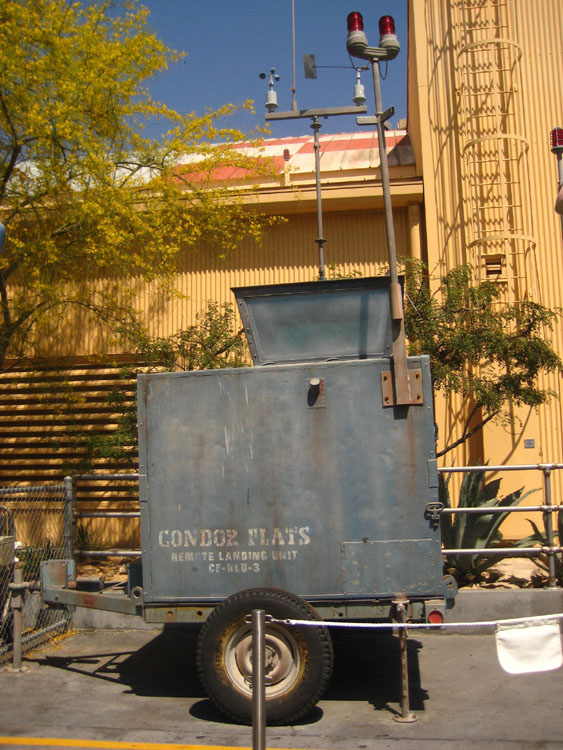
Here is the side view of the tower on display in Disneyland. Visitors waiting in line for the ride walk past this control tower.
Below this image are the labels on the tower.
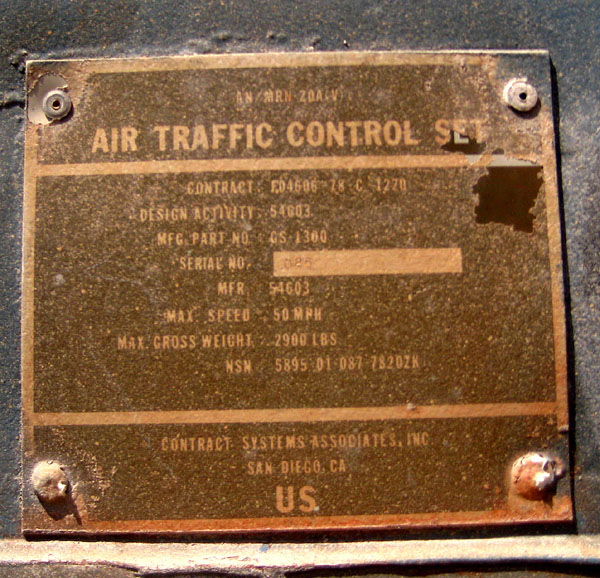
Because the text is hard to read, here is what is on this label:
AN/MRN - ZOA.V (or it could be ZQA.V)
Air Traffic Control Set
Contract : F04606 - 78 -C 1270
Design Activity : 54G03
MFG PART NO : GS - 1300
Serial NO. 025
MFR : 54603
MAX SPEED : 50 MPH
MAX GROSS WEIGHT : 2900 LBS
NSN : 5895 - 01 0 087 - 78202K
CONTRACT : SYSTEMS ASSOCIATES, INC.
SAN DIEGO, CA
US
Does anyone have information in Systems Associates, Inc. in San Diego?
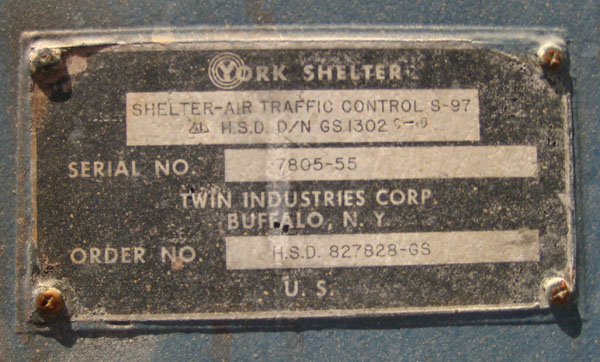
Here is the text on the York Shelter label:
York Shelter
Shelter - Air Traffic Control S-97
?? H.S.D. D/N GS1302 c-d
Serial NO. 7805-55
Twin Industries Corp.
Buffalo, N.Y.
Order No. H.S.D. 827828-GS
U.S.
I discovered that Twin Industries was a subcontractor in the 1950's to Lockheed and Grumann, presumably they were also a subcontractor to York. Maybe this is the same York of air conditioning fame.
I look forward to any information about the personnel and use of this unusual piece of military equipment.
July 2010 Update:
The Archives Division of the Smithsonian National Air and Space Museum was extremely helpful in providing additional information about this topic. It seems that the archive didn't have documentation on this system so they asked their naval aviator experts who would have served in areas and time periods where the equipment would have been used. It seems that the unit pictured on this web page was likely the "first" or "early" version of what eventually became the TSQ-6 a two-person shelter for the Landing Signal Officer along side the runway when Field Carrier Landing Practice operations were being performed. Perhaps the space for a second person was for training. But, that was the follow-on system. The smaller, system as shown here is believed to be a miniature tower and Meteorological Operations Control facility. It is believed to have been used on a field that had nothing more than a wind sock and an improved landing area. The mobile unit would be manned by and Air traffic Controller and an Aerographers Mate and they would be able to provide control tower services such as communications to air crews about weather (wind, temperature, barometric pressure) and if the field had lights they could control the lights. For simulated carrier approaches (see earlier comments about TSQ-6) the unit could be connected to a mobile Fresnel Lens System ("call the ball"). Respondents with the Smithsonian noted that some version of these systems had a small desk for notekeeping, and a porta-john. Maybe there were different sizes, the one pictured must be the smallest version.
In some places in the previous paragraph I copied or paraphrased language provided to me in a letter from I received from the Smithsonian.
There are no known photos for any of these small control towers being used in the field. If you have one (even in the background) please let me know. See the reference for email earlier on this page.
My sincere thanks to the Archive Division of the Smithsonian National Air and Space Museum for taking the time to track down this new information.
Greg Clark
Copyright Greg Clark, 2007
update 9/2012